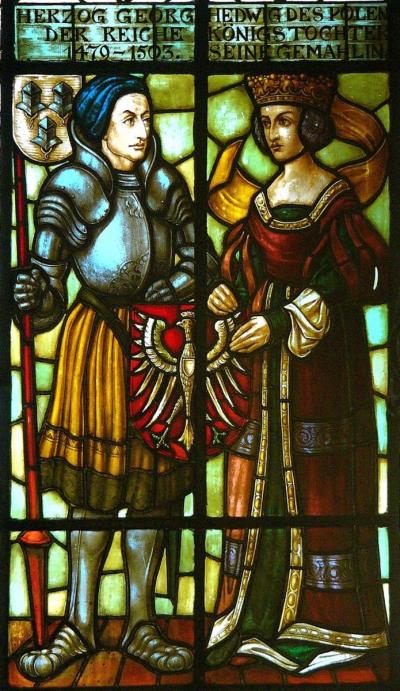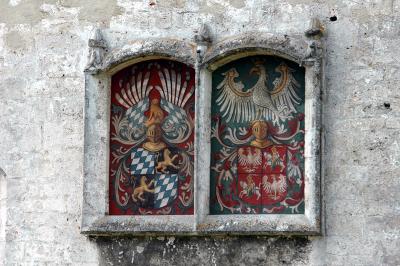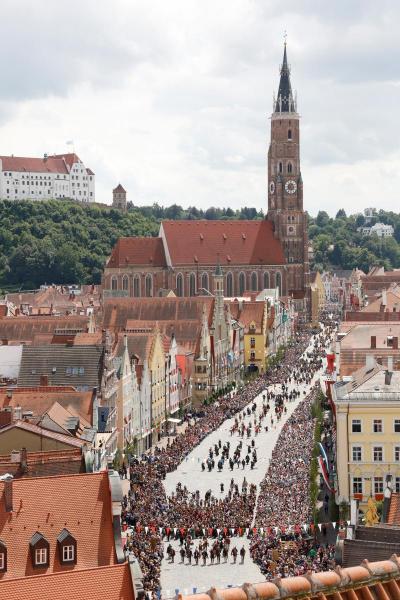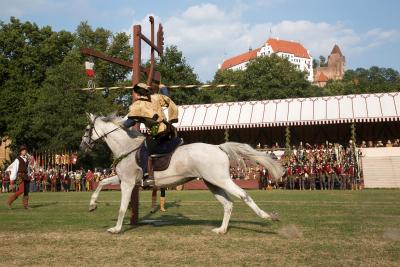Hedwig Jagiellon (Jadwiga Jagiellonka)
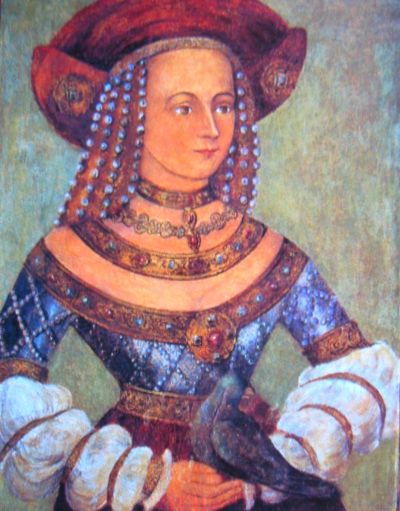
The wedding in Landshut is still generally acknowledged to be the most expensive wedding celebration in the late Middle Ages. The ceremony was led by no less a person than Kaiser Friedrich III. Amongst the invited guests were several hundred aristocrats from all over Europe, including Duke Otto II of Mosbach-Neumarkt, the son of Otto I., Markgraf Albrecht, Prince of Brandenburg, the Dukes Albrecht, Christoph and Wolfgang of Bayern-München, aristocratic priests like Archbishop Bernhard of Salzburg and the bishops of Bamberg, Eichstätt, Augsburg, Freising and Passau. A great many Polish aristocrats were also present with a retinue of around 10,000 persons. Food and drink, music and dance were not the only features of the day-long festivities: there were also tournaments where the most skilful knights in Europe could test their abilities amongst one another.
It was not only the celebration that was impressive, but also the political background and the efforts to conclude fresh royal alliances in Europe of the time.
The Jagiellonian dynasty first acceded to the Polish throne in 1386. In 1447 Kasimir IV came to the throne. He was one of the most active Polish rulers. His wife was Elizabeth of Habsburg. The couple had a total of thirteen children, the majority of whom were intended to reinforce the political dynasty. Whereas three of the male heirs inherited the throne of Poland successively, thereby securing the country at a domestic level, the daughters ensured stability with foreign countries by arranged marriages with other royal houses. This was also the case with the oldest daughter Hedwig, who was born on 21st September 1457 in Krakau. Her wedding was also planned right down to the last detail and serve to consolidate relations between the Polish royal family and the Duchy of Bavaria. Georg der Reiche, Duke of Bayern-Landshut, was a good match for the royal parents of Hedwig. But the wedding not only proved a fine arrangement for the Kingdom of Poland. The pious Duchess Hedwig set up many foundations. Her traces can still be found in Lower Bavaria, for example in the Landshut Churches of St. Jodok and St. Martin, in the parish church of St John in Dingolfing, in the parish church of Gollenhausen and in the place of pilgrimage, Altöttingen. After she was married Hedwig lived in the castle in Burghausen, albeit with a large court, but nevertheless very isolated. She bore five children: Ludwig of Bavaria Bayern (1476 - sometime before 1496), Ruprecht of Bavaria (*/† 1477), Elisabeth (1478–1504), Margarete (1480–1531) and Wolfgang of Bavaria (*/† 1482). The oldest daughter Elizabeth married Ruprecht von der Pfalz in 1499.
By contrast the younger daughter Margarete never married. When she was thirteen she entered the Dominican convent in Altenhohenau. From 1509 to 1521 she was the abbess of the Benedictine convent in Neuburg.
Hedwig Jagiellon died on 18th February 1502 in Burghausen. She was laid to rest in the church of the Cistercian monastery in Raitenhaslach. Today a plaque reminds visitors of the final resting place of Duchess Hedwig, who always signed off her name with “born as the Queen of Poland”.
Her husband, Duke Georg der Reiche, died one year later. Since there was no male heir this resulted in the Landshut Inheritance War of 1504.
Adam Gusowski, January 2016
Additional information:
In the Bavarian State Library in Munich there is still a parchment volume entitled “Was Kostung über Herzog Georgs des Reichen von Landshut Hochzeit erlaufen” (roughly, „What the Wedding Cost“). The contents give a precise list of expenses, the sequence of meals and a list of the guests present: This was later often used as a guide for royal weddings.
Over 9000 people celebrated the wedding for six whole days, during which they consumed 323 oxen, 490 calves, 969 pigs, 3295 sheep and lambs, 51,500 chickens and geese.
The mediaeval portrait of Duchess Hedwig by an unknown artist adorns the cover of the catalogue of the hitherto largest exhibition on German-Polish relationships: “Tür an Tür, Polen - Deutschland, 1000 Jahre Kunst und Geschichte”. (Berlin, Martin-Gropius-Bau, 2011/12). The original painting can now be seen in Trausnitz Fortress.

